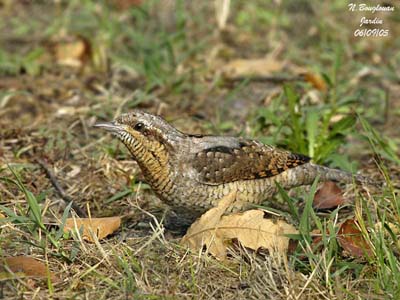
The Wryneck
( Jinx torquilla )
Piciforme Order – Picidae Family
“It advances stealthily, thanks to its scaled markings,
Probes the surroundings in search of ants.
Among the undergrowth, its cryptic feathering
Makes it invisible to the enemies’ eyes. ”

Thus I saw it a fine day of September, rummaging in the grass at the neighbour’s. While migrating southwards to Centre Africa, it found this suitable place to wait for the night and fly away towards its wintering areas. Its reptile-like appearance is not any more to show. Between scales and feathers, its autumn-coloured markings go unnoticed among dead leaves and dry grasses.
Its way of wavering between the clumps of vegetation makes more think of a snake than a bird. If disturbed on the ground or at nest, it contorts itself in such a way that its neck is stretched and twists in the extreme, giving to its head with erected feathers, an astonished expression which involuntarily involves us to also turn ours. It is not for nothing that it is called Wryneck! In order to push the comparison a little further, it combines snake-like whistles with these comic torsions. It is enough to discourage the potential predators, believing to be faced with a venomous opponent!
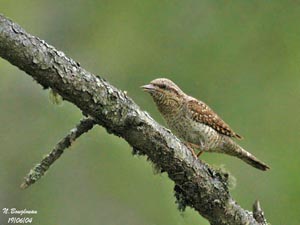
Its grey and brown plumage is a wonderful camouflage. The upperparts are very similar to the bark of a tree. It could use it to pass unnoticed if it acted like the woodpeckers, family to which it belongs. But its grey and rather square tail, made with flexible feathers prohibiting any support, does not allows him to climb like them on the tree trunks. It goes from tree to tree and examines all the cavities for nesting. It is able to perch like woodpeckers, stuck well to the trunk by the claws and pressed on the tail, but it moves very quickly and will settle across a branch, in a more traditional way.
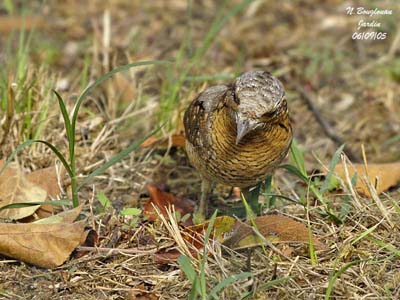
The underparts are finely streaked. Chin, throat, neck and upper breast show a buffy-ochre background with reddish-brown vermiculations, whereas lower breast and belly are yellowish-white, finely mottled, with the pattern getting softer and softer downwards.
Its flight is slow and undulating, and outside of migrations, it only performs short flights from tree to tree.
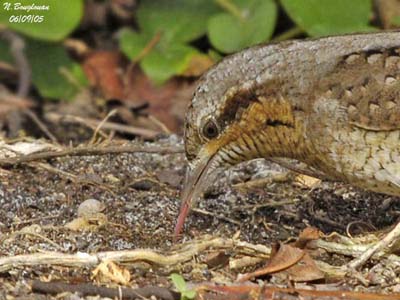
The pointed bill shelters a pinkish tongue, long of several centimetres, which it rolls up in a characteristic way when it does not search for its preferred food, the ants. It then uses this sticky tongue in a surprising way, seizing all the ants being within its range. It also consumes insects and larvae extracted from the bark crevices where they hide, and probes the interstices between the stones of the buildings, extracting easily cocoons and larvae. It also captures many spiders. On its wintering areas in Africa, it feeds mainly on black ants.
Its voice resembles a little that of the Lesser Spotted Woodpecker, giving a kind of “kei-kei-kei-kei” prolonged and fast, more intense at the end. Wryneck male and female sing: the male stronger and higher pitched than the female which sings lower and slower. Unlike the woodpeckers, it does not drum.
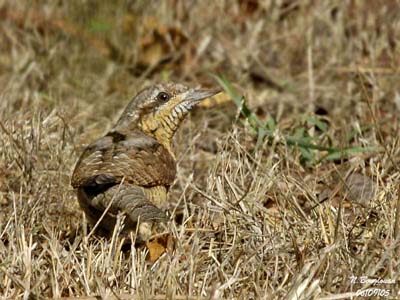
The Wryneck nests in natural cavities, such as old nests abandoned by other birds species, or in nest-boxes. The male seeks a nest-site as soon as it arrives in April. It examines all the holes, occupied or not. If a nest is already prepared, and even if there are eggs or chicks, it throws out all that is in the cavity. He is filled with a kind of destructive instinct which leaves it as soon as its own reproduction is on the way. The concerned species usually are Great Spotted Woodpeckers and Green Woodpeckers, Common Redstarts and Nuthatches, all the species which nest in cavities or adopt nest-boxes. The Wryneck does not hollow its nest. At best, it will remove some wood needles from the entrance for easier access.
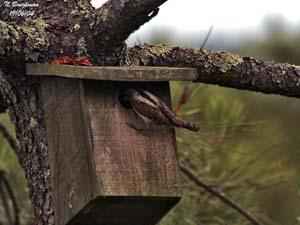
When all the suitable nest-sites of the area were visited, and the territory established, the male starts to sing continuously. The female examines the emptied cavities, and sings too, a little stronger than usually, perched close to the future nest when she likes it.
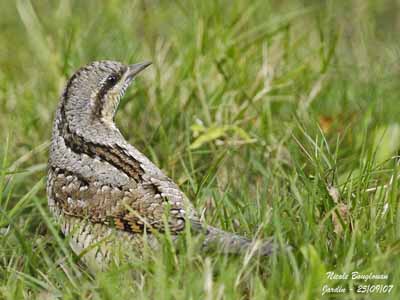
They are perched facing each other on two different branches in the same tree, but close to each other. At this moment, the male opens widely the bill as for a prolonged yawn, while it raises and bows the head, or “throws it” backwards. It remains thus a few moments, as sleeping, and then, it goes back to his first position, and erects the crown’s feathers while uttering a soft cackle, nevertheless audible as far as twenty-five metres!
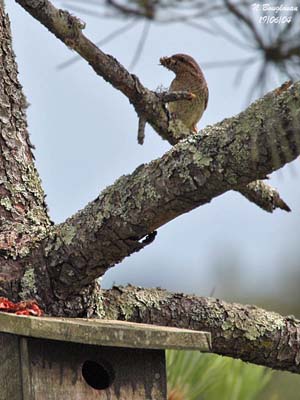
One month more will be necessary before the first laying, in the late May. The clutch is composed of seven to nine white eggs. As soon as the female starts to incubate, the male stops singing. Incubation lasts about 13 days, mainly by the female. The chicks hatch helped by their mother. A curious fact was observed: at this time, the female has the bill filled with a kind of yellowish paste which overflows by the commissures. Perhaps a substance intended to feed them at hatching? She broods the altricial chicks during the first five days, because they are almost naked. One week later, they grew, well fed by both parents which arrive at nest with the bill filled with food. The chicks are frequently fed with ants’ larvae, practically every ten minutes. While approaching the nest, the adults utter a short and repeated “teak” at regular intervals. The young leave the nest at three weeks of age, and abandon quickly the nest-site, because a second brood will be started, rarely a third.
The Wryneck breeds in the temperate areas of Europe and Asia. It winters in Tropical Africa and in Southern Asia. It is often decimated during its wintering in Africa where many fields are sprayed with insecticides in order to obtain better harvests, producing a biological imbalance which leads to the parasites’ destruction, but also to that of the useful species. Few birds of this species exceed the three years age. The majority of the breeding birds are wrynecks from the previous year.
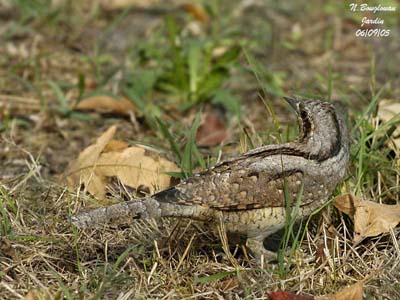
Between snake and bird, it does not matter! The Wryneck has the virtue of being different from the other species, whether by its appearance or its behaviours. I was lucky to be able to observe it very close, it is an attractive bird! I hope you will also like it, and these some lines will give you the desire for discovering its funny faces and its wonderful camouflage!
Text and photographs by Nicole Bouglouan
More pictures: PHOTOGRAPHIC RAMBLE
Sources:
THE HANDBOOK OF BIRD IDENTIFICATION FOR EUROPE AND THE WESTERN PALEARCTIC, by Mark Beaman, Steve Madge - C.Helm - ISBN: 0713639601
THE COMPLETE BOOK OF ENGLISH BIRDS - Préface de Magnus Magnusson - Michael Cady- Rob Hume - ISBN: 0749509112
Pájaros de España (JL Beamonte)